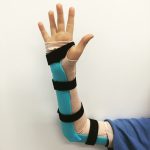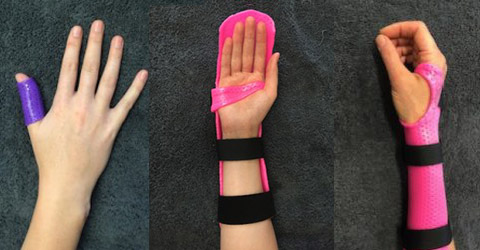
Thermoplastic splinting material is used when fabricating custom made splints. The splints can be made during a consultation with your hand therapist and may be remoulded to allow for reduction in swelling or to maximise comfort.
Thermoplastic splints differ from traditional plaster casting in that they are lighter, easily moulded to conform to the shape of the individual patient, and can be removed for exercise (if appropriate), cleaning and skin hygiene.
Casting
For a broken bone, your hand therapist can provide an appropriate casting option depending on your injury. Casting materials include plaster of paris and synthetic/fibreglass.
A plaster of paris is a white powder and when wet turns to a paste that hardens quickly, like chalk. Soft white padding is applied underneath the cast. It gets warm during the setting process and hardens quickly. Plaster of paris casting moulds and shapes well providing good immobilisation of the arm. It cannot get wet and is generally heavier than a fibreglass cast. A plaster of paris back slab, which is held on with a bandage, may be applied initially to allow for swelling fluctuation after injury.
 Uses for splinting
Uses for splinting
Splinting can be used to stabilise an injury prior to surgery.
Splinting can also provide immobilisation to areas of trauma in emergency rooms.
We use thermoplastic splints for a variety of reasons:
- to immobilise joints
- to protect healing wounds
- to allow joints to rest and heal
- for undisplaced fractures
- to avoid and/or correct deformity
- as blocking splints to wear during exercise
- dynamic splints can be used to increase range of motion.
Clinical examinations
Here at Hand Therapy Group, each of our therapists are trained in clinical reasoning to fabricate splints to serve a purpose. They understand upper limb and hand anatomy, including which joints need to be immobilised for different clinical conditions. As hand therapists, they aim to promote function while protecting only what needs to be protected.
Feel free to contact us to make an appointment or speak to a therapist to determine if custom splinting will benefit you, we’d be more than happy to help!
Here are some common thermoplastic splints for the arm, wrist and fingers:

